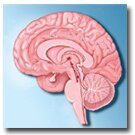Size Of Brain Structures Predicts Success
 Researchers can predict your performance on a video game simply by measuring the volume of specific structures in your brain, a multi-institutional team reports this week. Researchers can predict your performance on a video game simply by measuring the volume of specific structures in your brain, a multi-institutional team reports this week.
The new study, in the journal Cerebral Cortex, found that nearly a quarter of the variability in achievement seen among men and women trained on a new video game could be predicted by measuring the volume of three structures in their brains.
The study adds to the evidence that specific parts of the striatum, a collection of distinctive tissues tucked deep inside the cerebral cortex, profoundly influence a person's ability to refine his or her motor skills, learn new procedures, develop useful strategies and adapt to a quickly changing environment.
"This is the first time that we've been able to take a real world task like a video game and show that the size of specific brain regions is predictive of performance and learning rates on this video game," said Kirk Erickson, a professor of psychology at the University of Pittsburgh and first author on the study.
Ann Graybiel, an Institute Professor at the Massachusetts Institute of Technology and Investigator in the McGovern Institute for Brain Research; and Arthur Kramer, a professor of psychology at the Beckman Institute for Advanced Science and Technology at the University of Illinois, were co-principal investigators on the study. Walter Boot, of Florida State University, also contributed to the research.
Research has shown that expert video gamers outperform novices on many basic measures of attention and perception, but other studies have found that training novices on video games for 20 or more hours often yields no measurable cognitive benefits.
These contradictory findings suggest that pre-existing individual differences in the brain might predict variability in learning rates, the authors wrote.
Animal studies conducted by Graybiel and others led the researchers to focus on three brain structures: the caudate nucleus and the putamen in the dorsal striatum, and the nucleus accumbens in the ventral striatum.
"Our animal work has shown that the striatum is a kind of learning machine -- it becomes active during habit formation and skill acquisition," Graybiel said. "So it made a lot of sense to explore whether the striatum might also be related to the ability to learn in humans."
Source: University of Illinois at Urbana-Champaign
|